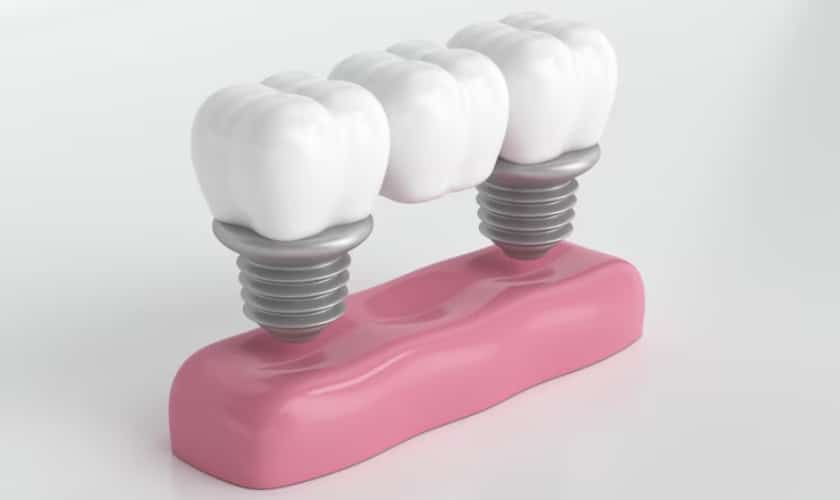Imagine this scenario: you’re savoring a tasty meal, sharing laughs with friends, when you feel an unexpected sensation in your mouth. Upon investigation, you realize that your dental bridge, previously fixed in its position, is now loose or hanging loosely. Stay composed! Although a loose dental bridge can be disconcerting, maintaining composure and following the correct procedures can assist you in managing this situation efficiently. This article will serve as your manual for dealing with a dislodged dental bridge. We will address all the necessary information, starting from immediate actions to post-care recommendations, ensuring a seamless journey towards restoring your full smile.
Understanding Dental Bridges
A dental bridge is an effective choice for replacing missing teeth as it connects artificial teeth, known as pontics, to your adjacent healthy teeth, effectively filling the gap. The pontics are carefully positioned and personalized to match your natural smile perfectly.
Benefits of Dental Bridges
Dental bridges offer numerous benefits beyond just improving appearance:
- Enhanced Functionality: Missing teeth can hinder chewing ability. Bridges restore this function, allowing you to enjoy a wider range of foods and aiding proper digestion.
- Improved Speech: Gaps in your smile can affect speech. Bridges fill these gaps, ensuring clear and confident communication.
- Boosted Confidence: A complete smile is vital for self-esteem. Bridges address the cosmetic concern of missing teeth, enabling you to smile confidently.
- Prevents Shifting Teeth: Missing teeth can cause adjacent teeth to shift, leading to bite problems and further tooth loss. Bridges prevent this movement, maintaining optimal dental alignment.
Factors that Compromise Longevity
Although dental bridges are widely known for their durability, certain factors may compromise their longevity:
- Daily Wear and Tear: Bridges, like any dental restoration, can undergo wear and tear over time, especially with regular use.
- Improper Brushing and Flossing: Maintaining good oral hygiene is essential. Inadequate brushing and flossing can lead to plaque buildup around the bridge and supporting teeth, increasing the risk of decay and loosening.
- Chewing Hard Objects: Using the bridge to chew hard objects like candies or ice can exert undue stress, potentially causing cracks or fractures.
- Underlying Dental Issues: Existing dental problems, such as gum disease or decay around the abutment teeth (supporting the bridge), can weaken its foundation and lead to failure.
Immediate Actions When Your Bridge Falls Out
Losing a dental bridge can be unexpected and concerning, but remaining calm and acting promptly can mitigate complications and facilitate a smooth recovery. Here’s a comprehensive guide on what to do:
Stay Calm and Assess the Damage
Pause and take a deep breath to maintain clarity of mind. Avoid panicking, as it can impede rational decision-making. Carefully inspect the bridge for cracks, chips, or fractures. Check for sharp edges that may cause discomfort or injury. Assess your mouth for signs of irritation, bleeding, or swelling around the exposed area where the bridge was.
Retrieve and Secure the Bridge Carefully
Locate the bridge and handle it gently, grasping it by the crowns—the tooth-shaped portions. Avoid touching the underside where it attaches to your teeth to prevent damage to delicate adhesives or clasps.
If there’s any dirt or debris on the bridge, rinse it carefully with lukewarm water. Use mild soap if necessary, but avoid harsh chemicals or abrasive cleaners. Then, place the bridge in a clean container or resealable plastic bag for safekeeping until your dentist appointment.
Clean Your Mouth Thoroughly
Rinse your mouth with warm salt water by dissolving half a teaspoon of table salt in a glass of warm water. This helps remove any debris and reduces the risk of infection. If possible, gently brush and floss around the exposed area, taking care not to dislodge any natural teeth.
What to Expect at The Dentist for a Loose Bridge
The following steps will guide you through your loose bridge dental visit:
Examination and Discussion
Thorough Examination: Your Airdrie dentist will meticulously examine your mouth, focusing on the loose bridge, surrounding teeth (abutment teeth), and gums. They assess the bridge’s fit, stability, and any signs of damage or wear.
Detailed Discussion: Your dentist in Airdrie will discuss your dental history, including past procedures and recent events that may have caused the bridge to loosen. This could range from chewing hard objects to teeth clenching or grinding.
Treatment Options
Based on the examination and diagnostics, your dentist will recommend the most suitable course of treatment, including:
- Re-cementing the Bridge: Ideal if the bridge and abutment teeth are healthy. Your dentist will clean them thoroughly and use dental adhesive to securely re-cement the bridge.
- Bridge Repair: Minor damage, like a chipped pontic, can be repaired using dental materials.
- New Bridge Creation: If the bridge is severely damaged or not salvageable, a completely new bridge may be necessary. Your dentist will discuss the design and fabrication process.
Preventing Future Dislodgement
Following the successful placement of your dental bridge, incorporate these essential practices into your daily routine to reduce the chances of future problems:
- Meticulous Brushing: Brush your teeth thoroughly twice a day with a soft-bristled toothbrush and fluoride toothpaste. Angle the brush at a 45-degree angle towards the gumline to clean beneath the bridge and along supporting teeth effectively.
- Flossing: Daily flossing removes plaque and food particles between teeth and under the bridge, preventing gum disease, which can affect bridge stability.
- Dietary Savvy: Maintain a healthy diet to support overall oral health and bridge longevity. Limit sugary and acidic foods to prevent tooth decay and weaken the teeth supporting the bridge.
- Chewing Cautiously: Avoid hard, chewy, or sticky foods that can stress the bridge and potentially cause damage or dislodgement. Be mindful of what you chew on with your bridge.
Experiencing a dislodged dental bridge can be unsettling, but staying calm and taking immediate action is key. Contacting your dentist in Airdrie promptly is crucial. By following these steps and attending your dental appointment, you can minimize complications and restore your smile. Don’t hesitate to discuss any questions or concerns with your dentist.


